中西节日文化差异 英文
- 格式:docx
- 大小:12.59 KB
- 文档页数:4
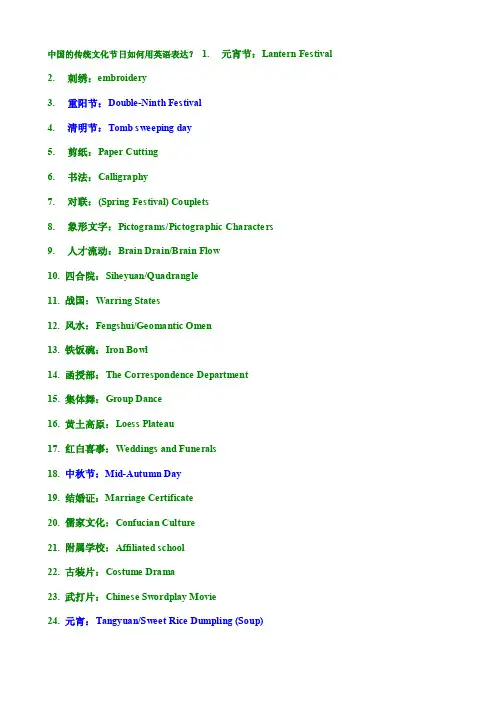
中国的传统文化节日如何用英语表达?1. 元宵节:Lantern Festival2. 刺绣:embroidery3. 重阳节:Double-Ninth Festival4. 清明节:Tomb sweeping day5. 剪纸:Paper Cutting6. 书法:Calligraphy7. 对联:(Spring Festival) Couplets8. 象形文字:Pictograms/Pictographic Characte rs9. 人才流动:Brain Drain/Brain Flow10. 四合院:Siheyuan/Quadrangle11. 战国:Warring States12. 风水:Fengshui/Geomantic Omen13. 铁饭碗:Iron Bowl14. 函授部:The Correspondence Department15. 集体舞:Group Dance16. 黄土高原:Loess Plateau17. 红白喜事:Weddings and Funerals18.中秋节:Mid-Autumn Day19. 结婚证:Marriage Certificate20. 儒家文化:Confucian Culture21. 附属学校:Affiliated school22. 古装片:Costume Drama23. 武打片:Chinese Swordplay Movie24. 元宵:Tangyuan/Sweet Rice Dumpling (Soup)25. 一国两制:One Country, Two Systems26. 火锅:Hot Pot27. 四人帮:Gang of Four28. 《诗经》:The Book of Songs29. 素质教育:Essential-qualities-oriented Education30. 《史记》:Historical Records/Records of the Grand Historian31. 大跃进:Great Leap Forward (Movement)32. 《西游记》:The Journey to the West33. 除夕:Chinese New Year’s Eve/Eve of the Spring Festival34. 针灸:Acupuncture35. 唐三彩:Tri-color Pottery of the Tang Dynasty/The Tang Tri-colored pottery36. 中国特色的社会主义:Chinese-charactered Socialist/Socialist with Chinese characteristics37. 偏旁:radical38. 孟子:Mencius39. 亭/阁:Pavilion/ Attic40. 大中型国有企业:Large and Medium-sized State-owned Enterprises41. 火药:gunpowder42. 农历:Lunar Calendar43. 印/玺:Seal/Stamp44. 物质精神文明建设:The Construction of Material Civilization and Spiritual Civilization45. 京剧:BeijingOpera/Peking Opera46. 秦腔:Crying of Qin People/Qin Opera47. 太极拳:Tai Chi48. 独生子女证:The Certificate of One-child49. 天坛:Altar of Heaven in Beijing50. 小吃摊:Snack Bar/Snack Stand51. 红双喜:Double Happiness52. 政治辅导员:Political Counselor/School Counselor53. 春卷:Spring Roll(s)54. 莲藕:Lotus Root55. 追星族:Star Struck56. 故宫博物院:The Palace Museum57. 相声:Cross-talk/Comic Dialogue58. 下岗:Lay off/Laid off59. 北京烤鸭:BeijingRoast Duck60. 高等自学考试:Self-taught Examination of Higher Education61. 烟花爆竹:fireworks and firecracker62. 敦煌莫高窟:MogaoCaves63. 电视小品:TV Sketch/TV Skit64. 香港澳门同胞:Compatriots from Hong Kong and Macao65. 文化大革命:Cultural Revolution66. 长江中下游地区:The Mid-low Reaches of Yangtze River67. 门当户对:Perfect Match/Exact Match68. 《水浒》:Water Margin/Outlaws of the Marsh69. 中外合资企业:Joint Ventures70. 文房四宝(笔墨纸砚):"The Four Treasure of the Study" "Brush, Inkstick, Paper, and Inkstone",文- 汉语汉字编辑词条文,wen,从玄从爻。
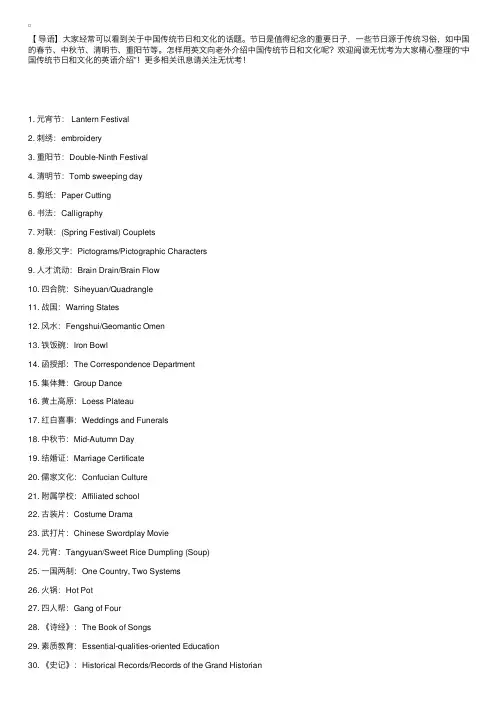
【导语】⼤家经常可以看到关于中国传统节⽇和⽂化的话题。
节⽇是值得纪念的重要⽇⼦,⼀些节⽇源于传统习俗,如中国的春节、中秋节、清明节、重阳节等。
怎样⽤英⽂向⽼外介绍中国传统节⽇和⽂化呢?欢迎阅读⽆忧考为⼤家精⼼整理的“中国传统节⽇和⽂化的英语介绍”!更多相关讯息请关注⽆忧考!1. 元宵节: Lantern Festival2. 刺绣:embroidery3. 重阳节:Double-Ninth Festival4. 清明节:Tomb sweeping day5. 剪纸:Paper Cutting6. 书法:Calligraphy7. 对联:(Spring Festival) Couplets8. 象形⽂字:Pictograms/Pictographic Characters9. ⼈才流动:Brain Drain/Brain Flow10. 四合院:Siheyuan/Quadrangle11. 战国:Warring States12. 风⽔:Fengshui/Geomantic Omen13. 铁饭碗:Iron Bowl14. 函授部:The Correspondence Department15. 集体舞:Group Dance16. 黄⼟⾼原:Loess Plateau17. 红⽩喜事:Weddings and Funerals18. 中秋节:Mid-Autumn Day19. 结婚证:Marriage Certificate20. 儒家⽂化:Confucian Culture21. 附属学校:Affiliated school22. 古装⽚:Costume Drama23. 武打⽚:Chinese Swordplay Movie24. 元宵:Tangyuan/Sweet Rice Dumpling (Soup)25. ⼀国两制:One Country, Two Systems26. ⽕锅:Hot Pot27. 四⼈帮:Gang of Four28. 《诗经》:The Book of Songs29. 素质教育:Essential-qualities-oriented Education30. 《史记》:Historical Records/Records of the Grand Historian31. ⼤跃进:Great Leap Forward (Movement)32. 《西游记》:The Journey to the West33. 除⼣:Chinese New Year’s Eve/Eve of the Spring Festival34. 针灸:Acupuncture35. 唐三彩:Tri-color Pottery of the Tang Dynasty/ The Tang Tri-colored pottery36. 中国特⾊的社会主义:Chinese-charactered Socialist/Socialist with Chinesecharacteristics37. 偏旁:radical38. 孟⼦:Mencius39. 亭/阁: Pavilion/ Attic40. ⼤中型国有企业:Large and Medium-sized State-owned Enterprises41. *:gunpowder42. 农历:Lunar Calendar43. 印/玺:Seal/Stamp44. 物质精神⽂明建设:The Construction of Material Civilization and Spiritual Civilization45. 京剧:Beijing Opera/Peking Opera46. 秦腔:Crying of Qin People/Qin Opera47. 太极拳:Tai Chi48. 独⽣⼦⼥证:The Certificate of One-child49. 天坛:Altar of Heaven in Beijing50. ⼩吃摊:Snack Bar/Snack Stand51. 红双喜:Double Happiness52. 政治辅导员:Political Counselor/School Counselor53. 春卷:Spring Roll(s)54. 莲藕:Lotus Root55. 追星族:Star Struck56. 故宫博物院:The Palace Museum57. 相声:Cross-talk/Comic Dialogue58. 下岗:Lay off/Laid off59. 北京烤鸭:Beijing Roast Duck60. ⾼等⾃学考试:Self-taught Examination of Higher Education61. *:fireworks and firecracker62. 敦煌莫⾼窟:Mogao Caves63. 电视⼩品:TV Sketch/TV Skit64. ⾹港澳门同胞:Compatriots from Hong Kong and Macao65. *:Cultural Revolution66. 长江中下游地区:The Mid-low Reaches of Yangtze River67. 门当户对:Perfect Match/Exact Match68. 《⽔浒》:Water Margin/Outlaws of the Marsh69. 中外合资企业:Joint Ventures70. ⽂房四宝(笔墨纸砚):"The Four Treasure of the Study" "Brush, Inkstick, Paper, and Inkstone"71.兵马俑:cotta Warriors/ Terracotta Army72.旗袍:cheongsam。
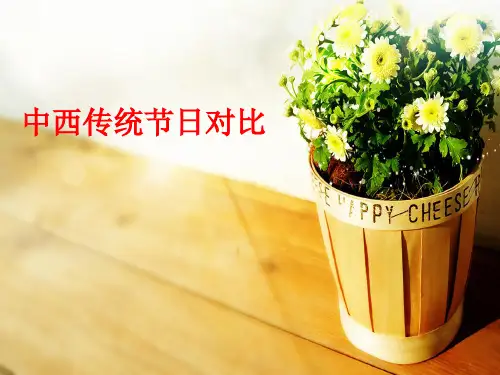
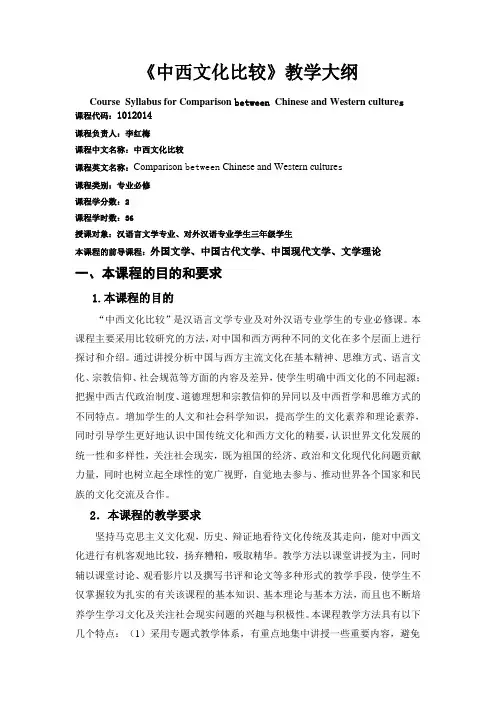
《中西文化比较》教学大纲Course Syllabus for Comparison between Chinese and Western culture s课程代码:1012014课程负责人:李红梅课程中文名称:中西文化比较课程英文名称:Comparison between Chinese and Western culture s课程类别:专业必修课程学分数:2课程学时数:36授课对象:汉语言文学专业、对外汉语专业学生三年级学生本课程的前导课程:外国文学、中国古代文学、中国现代文学、文学理论一、本课程的目的和要求1.本课程的目的“中西文化比较”是汉语言文学专业及对外汉语专业学生的专业必修课。
本课程主要采用比较研究的方法,对中国和西方两种不同的文化在多个层面上进行探讨和介绍。
通过讲授分析中国与西方主流文化在基本精神、思维方式、语言文化、宗教信仰、社会规范等方面的内容及差异,使学生明确中西文化的不同起源;把握中西古代政治制度、道德理想和宗教信仰的异同以及中西哲学和思维方式的不同特点。
增加学生的人文和社会科学知识,提高学生的文化素养和理论素养,同时引导学生更好地认识中国传统文化和西方文化的精要,认识世界文化发展的统一性和多样性,关注社会现实,既为祖国的经济、政治和文化现代化问题贡献力量,同时也树立起全球性的宽广视野,自觉地去参与、推动世界各个国家和民族的文化交流及合作。
2.本课程的教学要求坚持马克思主义文化观,历史、辩证地看待文化传统及其走向,能对中西文化进行有机客观地比较,扬弃糟粕,吸取精华。
教学方法以课堂讲授为主,同时辅以课堂讨论、观看影片以及撰写书评和论文等多种形式的教学手段,使学生不仅掌握较为扎实的有关该课程的基本知识、基本理论与基本方法,而且也不断培养学生学习文化及关注社会现实问题的兴趣与积极性。
本课程教学方法具有以下几个特点:(1)采用专题式教学体系,有重点地集中讲授一些重要内容,避免流水账式的历史叙述。
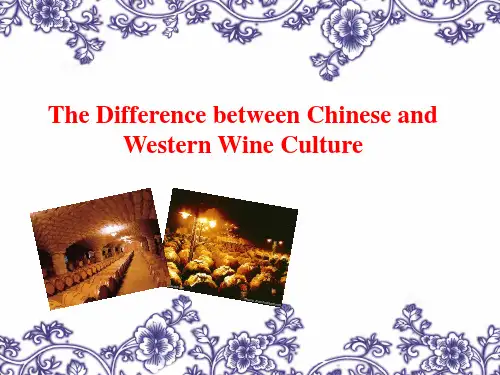
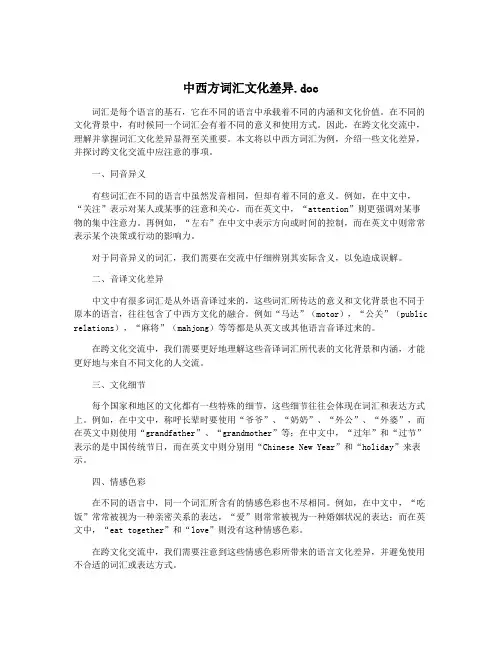
中西方词汇文化差异.doc词汇是每个语言的基石,它在不同的语言中承载着不同的内涵和文化价值。
在不同的文化背景中,有时候同一个词汇会有着不同的意义和使用方式。
因此,在跨文化交流中,理解并掌握词汇文化差异显得至关重要。
本文将以中西方词汇为例,介绍一些文化差异,并探讨跨文化交流中应注意的事项。
一、同音异义有些词汇在不同的语言中虽然发音相同,但却有着不同的意义。
例如,在中文中,“关注”表示对某人或某事的注意和关心,而在英文中,“attention”则更强调对某事物的集中注意力。
再例如,“左右”在中文中表示方向或时间的控制,而在英文中则常常表示某个决策或行动的影响力。
对于同音异义的词汇,我们需要在交流中仔细辨别其实际含义,以免造成误解。
二、音译文化差异中文中有很多词汇是从外语音译过来的,这些词汇所传达的意义和文化背景也不同于原本的语言,往往包含了中西方文化的融合。
例如“马达”(motor),“公关”(public relations),“麻将”(mahjong)等等都是从英文或其他语言音译过来的。
在跨文化交流中,我们需要更好地理解这些音译词汇所代表的文化背景和内涵,才能更好地与来自不同文化的人交流。
三、文化细节每个国家和地区的文化都有一些特殊的细节,这些细节往往会体现在词汇和表达方式上。
例如,在中文中,称呼长辈时要使用“爷爷”、“奶奶”、“外公”、“外婆”,而在英文中则使用“grandfather”、“grandmother”等;在中文中,“过年”和“过节”表示的是中国传统节日,而在英文中则分别用“Chinese New Year”和“holiday”来表示。
四、情感色彩在不同的语言中,同一个词汇所含有的情感色彩也不尽相同。
例如,在中文中,“吃饭”常常被视为一种亲密关系的表达,“爱”则常常被视为一种婚姻状况的表达;而在英文中,“eat together”和“love”则没有这种情感色彩。
在跨文化交流中,我们需要注意到这些情感色彩所带来的语言文化差异,并避免使用不合适的词汇或表达方式。
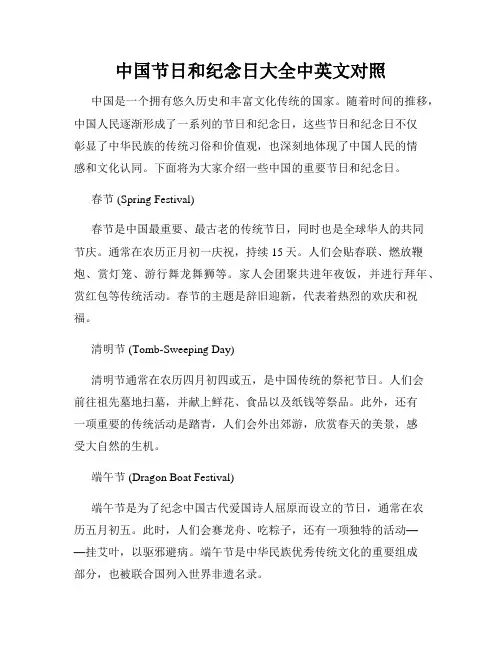
中国节日和纪念日大全中英文对照中国是一个拥有悠久历史和丰富文化传统的国家。
随着时间的推移,中国人民逐渐形成了一系列的节日和纪念日,这些节日和纪念日不仅彰显了中华民族的传统习俗和价值观,也深刻地体现了中国人民的情感和文化认同。
下面将为大家介绍一些中国的重要节日和纪念日。
春节 (Spring Festival)春节是中国最重要、最古老的传统节日,同时也是全球华人的共同节庆。
通常在农历正月初一庆祝,持续15天。
人们会贴春联、燃放鞭炮、赏灯笼、游行舞龙舞狮等。
家人会团聚共进年夜饭,并进行拜年、赏红包等传统活动。
春节的主题是辞旧迎新,代表着热烈的欢庆和祝福。
清明节 (Tomb-Sweeping Day)清明节通常在农历四月初四或五,是中国传统的祭祀节日。
人们会前往祖先墓地扫墓,并献上鲜花、食品以及纸钱等祭品。
此外,还有一项重要的传统活动是踏青,人们会外出郊游,欣赏春天的美景,感受大自然的生机。
端午节 (Dragon Boat Festival)端午节是为了纪念中国古代爱国诗人屈原而设立的节日,通常在农历五月初五。
此时,人们会赛龙舟、吃粽子,还有一项独特的活动——挂艾叶,以驱邪避病。
端午节是中华民族优秀传统文化的重要组成部分,也被联合国列入世界非遗名录。
中秋节 (Mid-Autumn Festival)中秋节是一个家庭团聚的节日,通常在农历八月十五。
人们会赏月、吃月饼、赏菊花等。
中秋节的核心是月亮,代表着团聚和祝福。
此外,也有丰富多样的民间故事和传说与中秋节相关联,如嫦娥奔月、吴刚伐桂等。
国庆节 (National Day)国庆节是中国的国家节日,于每年的十月一日庆祝,持续7天。
这是一个庆祝中华人民共和国成立的节日,人们会进行各种形式的庆祝活动,如升国旗仪式、阅兵式、文艺演出等。
国庆节是中国人民爱国主义情感的集中表达,也是对中华民族伟大历史和深厚文化底蕴的庆祝。
五四青年节 (Youth Day)五四青年节是为了纪念1919年五四运动而设立的节日,同时也是世界青年节。
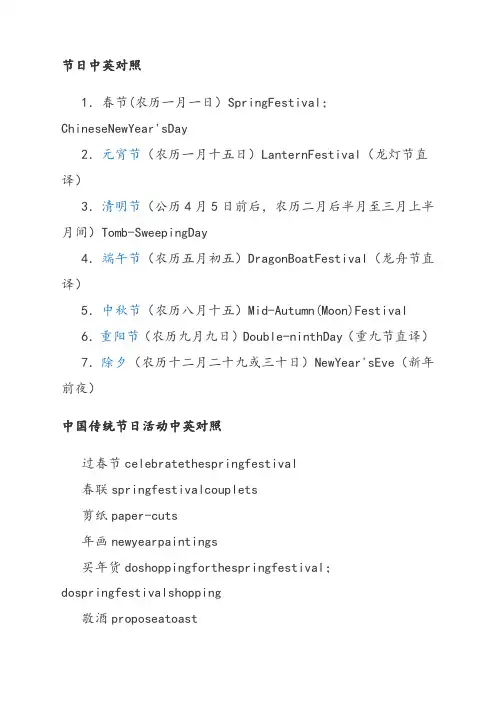
节日中英对照1.春节(农历一月一日)SpringFestival;ChineseNewYear'sDay2.元宵节(农历一月十五日)LanternFestival(龙灯节直译)3.清明节(公历4月5日前后,农历二月后半月至三月上半月间)Tomb-SweepingDay4.端午节(农历五月初五)DragonBoatFestival(龙舟节直译)5.中秋节(农历八月十五)Mid-Autumn(Moon)Festival6.重阳节(农历九月九日)Double-ninthDay(重九节直译)7.除夕(农历十二月二十九或三十日)NewYear'sEve(新年前夜)中国传统节日活动中英对照过春节celebratethespringfestival春联springfestivalcouplets剪纸paper-cuts年画newyearpaintings买年货doshoppingforthespringfestival;dospringfestivalshopping敬酒proposeatoast灯笼lantern烟花fireworks爆竹firecrackers(peoplescareoffevilspiritsandghostswiththel oudpop.)红包redpackets(cashwrappedupinredpaper,symbolizefortuneandwealthinthecomingyear.)舞狮liondance(thelionisbelievedtobeabletodispelevilandbring goodluck.)舞龙dragondance(toexpectgoodweatherandgoodharvests) 戏曲traditionalopera杂耍varietyshow灯谜riddleswrittenonlanterns灯会exhibitoflanterns守岁staying-up拜年paynewyear'scall;givenewyear'sgreetings;paynewyear'svisit禁忌taboo去晦气getridoftheill-fortune祭祖宗offersacrificestoone'sancestors压岁钱giftmoney;moneygiventochildrenasalunarnewyeargiftculturenote;intheolddays,newyear'smoneywasgivenintheformofonehundredcoppercoinss trungtogetheronaredstringandsymbolizedthehopethatonewou ldlivetobeahundredyearsold.today,moneyisplacedinsidered envelopesindenominationsconsideredauspiciousandgiventor epresentluckandwealth辞旧岁bidfarewelltotheoldyear扫房springcleaning;generalhouse-cleaning年糕nian-gao;risecake;newyearcake团圆饭familyreuniondinner年夜饭thedinneronnewyear'seve饺子jiao-zi/dumpling;Chinesemeatravioli粽子ricedumpling。
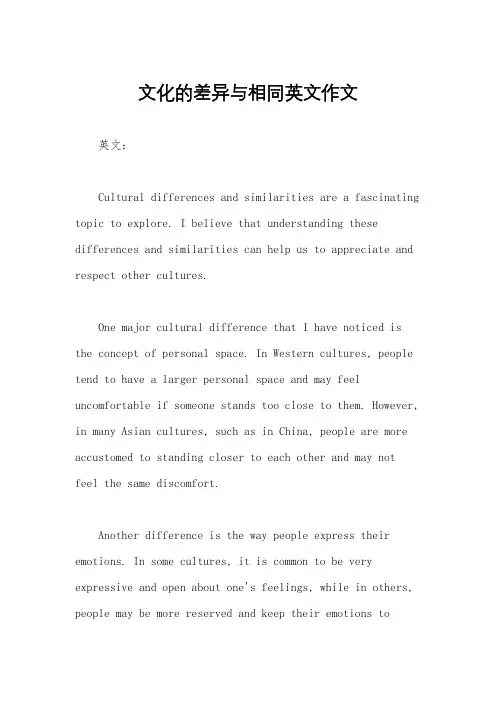
文化的差异与相同英文作文英文:Cultural differences and similarities are a fascinating topic to explore. I believe that understanding these differences and similarities can help us to appreciate and respect other cultures.One major cultural difference that I have noticed is the concept of personal space. In Western cultures, people tend to have a larger personal space and may feel uncomfortable if someone stands too close to them. However, in many Asian cultures, such as in China, people are more accustomed to standing closer to each other and may notfeel the same discomfort.Another difference is the way people express their emotions. In some cultures, it is common to be very expressive and open about one's feelings, while in others, people may be more reserved and keep their emotions tothemselves. For example, in American culture, it is often encouraged to express oneself and be open about emotions, while in Japanese culture, people may be more reserved and stoic.Despite these differences, there are also many similarities across cultures. For example, the value of family is universal. In both Western and Eastern cultures, family is considered to be extremely important, and people often prioritize spending time with their loved ones.In addition, many cultures also share similar values such as respect for elders, the importance of education,and the celebration of holidays and traditions. For example, in both Chinese and American cultures, there is a strong emphasis on respecting elders and valuing their wisdom and experience.中文:文化的差异与相同是一个非常有趣的话题。
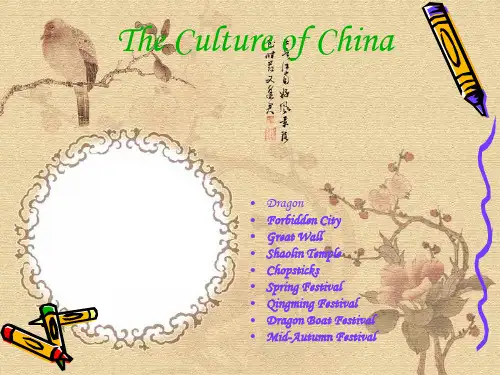

高中英语《Festivals》教案设计1一、教学目标1. 知识目标:学生能够掌握描述节日的相关词汇和表达方式,准确描述不同节日的特点。
2. 能力目标:通过对比分析中西方节日文化差异,提升学生的英语表达能力和跨文化交际能力。
3. 情感目标:让学生了解中西方节日文化的丰富内涵,培养学生对不同文化的尊重和欣赏。
二、教学重点与难点1. 教学重点(1)掌握描述节日的词汇和句型。
(2)了解中西方节日文化差异。
2. 教学难点(1)如何准确地用英语表达中国传统节日的特点。
(2)引导学生在跨文化交流中正确运用所学知识。
三、教学方法1. 情景教学法:通过图片、视频等创设节日氛围,让学生身临其境感受不同节日的特点。
2. 任务驱动法:布置节日文化知识竞赛和手抄报制作等任务,激发学生学习动力。
3. 合作学习法:组织学生进行小组讨论和合作,培养学生的团队合作精神和交流能力。
四、教学过程1. 导入(5 分钟)(1)播放一段关于世界各地节日庆祝的视频,让学生感受不同节日的欢乐氛围。
(2)提问学生:“What festivals do you know?”引导学生说出一些熟悉的节日名称。
2. 背景介绍(5 分钟)介绍本节课的主题是“Festivals”,让学生了解不同国家和地区都有自己独特的节日文化。
3. 作者介绍((可省略,因为通常高中英语教材中的课文不一定有特定作者)4. 课文朗读(10 分钟)(1)教师播放课文录音,学生边听边看课文。
(2)让学生跟读课文,注意语音语调。
5. 问题思考(10 分钟)(1)提出问题:“What are the main festivals mentioned in the text?”让学生快速浏览课文,找出文中提到的节日。
(2)“What are the characteristics of these festivals?”引导学生分析这些节日的特点。
6. 知识讲解(15 分钟)(1)讲解课文中的重点词汇和句型,如“celebrate”“traditional”“be known for”等。
西方的文化传统节日英文Title: Christmas: A Time for Joy and Giving。
Christmas is a time of joy and giving in the Western cultural tradition. It is a holiday that is celebrated with great enthusiasm and fervor, as people come together to exchange gifts, share meals, and enjoy the festive atmosphere.The origins of Christmas can be traced back to the birth of Jesus Christ, and it is a time for Christians to celebrate the birth of their savior. However, over the years, Christmas has evolved into a holiday that is celebrated by people of all faiths and backgrounds, as a time to come together and spread love and joy.One of the most beloved traditions of Christmas is the giving of gifts. People spend weeks or even months searching for the perfect presents for their loved ones, and the act of giving brings great joy and happiness to both the giver and the receiver. It is a time for expressing gratitude and appreciation for the people in our lives, and for showing them how much they mean to us.Another important aspect of Christmas is the gathering of family and friends. Whether it's a big family dinner or a cozy get-together with close friends, Christmas is a time for coming together and enjoying each other's company. The holiday season is filled with laughter, conversation, and shared memories, as people take the time to connect and strengthen their relationships.Decorating the home is also an integral part of the Christmas tradition. From putting up a Christmas tree to hanging stockings and lights, the festive decorations add to the joyous atmosphere of the holiday. The twinkling lights and colorful ornaments create a sense of warmth and happiness, and they serve as a reminder of the joy and magic of the season.In addition to the festivities, Christmas is also a time for giving back to those in need. Many people participate in charitable activities, such as volunteering at shelters, donating to food banks, or participating in toy drives for underprivileged children. The spirit ofgiving is at the heart of Christmas, and many people take this opportunity to make a positive impact in their communities.Overall, Christmas is a time for joy, love, and giving. It is a time to celebrate the spirit of generosity and togetherness, and to spread happiness and goodwill to all. As we come together to celebrate this special holiday, let us remember the true meaning of Christmas and embrace the traditions that bring us closer to one another. Merry Christmas to all!。
传统节日文化习俗相关的英文作文Traditional Festivals and Cultural CustomsIntroductionTraditional festivals play an important role in preserving cultural heritage and promoting community cohesion. Throughout history, people around the world have celebrated various festivals to commemorate their beliefs, values, and traditions. These festivals are often characterized by unique customs, rituals, and practices that have been passed down through generations. In this essay, we will explore some of the most prominent traditional festivals and cultural customs from different regions of the world.Chinese FestivalsChina is renowned for its vibrant and diverse range of festivals, each of which reflects the country's rich cultural heritage. One of the most prominent Chinese festivals is the Spring Festival, also known as Chinese New Year. This festival, which marks the beginning of the lunar new year, is celebrated with family gatherings, feasting, fireworks, and the exchange of red envelopes containing money. Another popular Chinesefestival is the Mid-Autumn Festival, which is celebrated with mooncakes, lanterns, and reunions with family and friends.Indian FestivalsIndia is a land of festivals, with each state and region celebrating a unique set of festivals throughout the year. One of the most widely celebrated Indian festivals is Diwali, also known as the Festival of Lights. During Diwali, people decorate their homes with clay lamps, burst firecrackers, and exchange sweets with their loved ones. Another popular Indian festival is Holi, the festival of colors, where people play with colored powders and water to celebrate the arrival of spring.Japanese FestivalsJapan has a rich cultural heritage that is reflected in its traditional festivals and customs. One of the most famous Japanese festivals is Sakura Matsuri, the cherry blossom festival, which celebrates the arrival of spring and the blooming of cherry blossoms. Another prominent Japanese festival is Obon, a Buddhist festival where people honor their deceased ancestors by visiting their graves and performing traditional dances.Spanish FestivalsSpain is known for its vibrant and colorful festivals, which are celebrated with great enthusiasm and passion. One of the most famous Spanish festivals is La Tomatina, a tomato-throwing festival held in the town of Buño l. Another popular Spanish festival is Feria de Abril, a week-long festival in Seville that is famous for its flamenco dancing, bullfighting, and traditional Spanish cuisine.ConclusionTraditional festivals and cultural customs play a vital role in preserving cultural heritage and promoting community cohesion. By celebrating these festivals, people can connect with their roots, strengthen their sense of identity, and foster a sense of belonging to a larger community. As we continue to navigate the complexities of the modern world, it is important to cherish and preserve these traditions for future generations to enjoy and appreciate.(Word count: 348)。
高中英语作文猜测与训练(二)语言文化◆语言文化☆命题猜测针对该话题,我们猜测高考命题人员可能会从以下角度来命题:介绍中外节日或重大大事或某一组织,谈谈英语学习的体会(方法、策略、困难、心得、经受)、对英美英语差别的理解和体验、语言学习策略、语言学习与文化的关系、爱护文化遗产,以及如何进行有效交际等。
举例如下:(1)介绍中国或外国的某一节日、某一文化活动或某一重大大事。
(2)为“英美英语差别”的讲座或为“我的英语学习之路”的英语演讲写一则海报。
(3)为某报社写一篇有关英语学习方法、学习策略与学习困难等方面的调查报告。
(4)谈论你宠爱的一句英语名言并说明缘由(5)介绍你参与以“了解本地文化与风俗、拓宽视野、加强友情”为目的一次国外夏令营活动。
(6)就“语言学习中,了解文化的必要性”的主题发表看法。
(7)就“如何解决中同学英语学习中的困难”的主题发表看法。
(8)就“如何爱护文化遗产”的主题发表看法。
☆必备词句◆1.语言学习(1)扩大某人的词汇量(2) 查字典(3)强调语法学习(4)养成阅读习惯(5)阅读技能/策略/力量(6)我的阅历告知我……(7)我每天练习听力两小时。
(8)我觉得学习英语语法最难。
(9)一个人动机越强,学习外语就越快。
◆2.英美英语差别(1)美国/英国英语(2)在语法方面有一点/很大的差别。
(3) 对于这两者的区分,我感到很迷惑。
3.语言与文化(1)language learning(2)culture difference /diversity(3)cultivate cross-cultural awareness(4)Respect others’culture and custom(5)Culture plays an important role in language learning.(6)Culture understanding enables us to ...(7)It is high time for us to treasure and protect culture relics.◆4.写作常用的高级句式(1)In the course of my schooling,I will never forget the great difficulty I encountered in learning English. 在我求学的过程中,我忘不了学习英语的巨大困难。
1.入土为安中文解释:入土为安意思是土葬,人死后埋入土中,死者方得安息。
英文翻译:brings peace to the deceased.brings peace to the deceased.文化内涵: 它最初的意思是,在原始社会,有族人死去,只是将遗体扔在野外,后来人们发现遗体会被野兽吃掉,后用草席包裹,然也会被野兽扒开,再后来就进入棺椁时期,将遗体放在棺材中埋在地下,才能在一定程度上避免受自然环境的侵蚀。
因此死者才能得到安息。
文化差异:中国民间传统的丧葬方式是土葬,把人装入棺材,然后埋入土中。
西方丧葬礼俗主要受基督教文化的影响。
基督教将每一个人的灵魂直接与上帝发生关系,崇尚灵魂升华而轻视肉体,西方的丧葬风俗是简丧薄葬。
因此虽然西方也有土葬形式,但是基督教的丧礼更多重视的是为死者祈祷,祝其灵魂早日升人天堂,解脱生前痛苦。
所以丧葬仪式的必要程序是先把棺材运人教堂,由一位教士念悼词并为死者祈祷。
因此我们认为在翻译过程中,如果异化,则翻译出“祈祷”。
2.含笑九泉:中文解释:在九泉之下满含笑容。
表示死后也感到欣慰和高兴。
九泉:地下深处,旧指人死之后埋葬的地方。
也作:“黄泉”。
英文翻译:smile under the Jiuquan(Jiuquan: In China, it is a place under the earth where people are believed to go when they die)smile in the Heaven文化内涵:它是出自清·李汝珍的《镜花缘》第三回:“我儿前去,得能替我出半臂之劳,我亦含笑九泉。
”九泉,即黄泉,古代认为天地玄黄,而泉在地下,所以称为黄泉。
在中国道家文化中是指人死后所往之地,也就是阴曹地府。
“九”是个位数中最长的数字。
因此我国古代常用“九”表示多、大、极的意思。
“阴曹地府”在很深的地下,于是就把“九”字和“泉”字相搭配,成为“九泉”。
The comparison between Chinese and Western festivals 中西方节日文化的差异比较 Abstract: the process of comparing the Chinese and Western festivals and studying
Western histories and cultures can help people promote the communication and understanding of different cultures. With the further development of society and inter-cultures, globalization will affect many aspects of life in all countries. And western festivals are becoming more and more popular in China. We should respect them and select the essence. China boasts a brilliant history and splendid traditions. In modern times, Chinese tradition should be preserved and promoted. But it seems that young people no longer treasure the tradition. On the contrary, they turn to pursue enthusiastically a seemingly more modern culture. If this trend is allowed to continue, the priceless heritage of our ancestors will be replaced by western traditions. Nobody expects such a consequence. So let’s join hand in hand to protect and carry forward Chinese tradition.
Key words: Traditional festivals; Chinese and Western cultures; difference;
globalization Introduction:
“A holiday of a nation represents a glorious culture and concentrated customs of a nation.” To understand a nation's cultural implications and its cultural characteristics, we must start with its traditional festivals. There exists great difference between Chinese and Western festivals due to their different languages, education, life styles and customs. Recently, western festivals are becoming more and more popular among Chinese. On one hand, it can indeed bring some benefits to our country to some extent. On the other hand, we should pay attention to this phenomenon. The differences in their origin and shaping, celebration, food, banquet manners, color of festive dressing and the attitudes of accepting presents contribute to the great differences of Chinese and Western festive cultures. On the background of globalization, we should pay respect to western festivals, and carry forward our excellent traditional festivals at the same time. “A holiday of a nation represents a glorious culture and concentrated customs of a nation.” To understand a nation's cultural implications and its cultural characteristics, we must start with its traditional festivals. There exists great difference between the Chinese and Western festivals due to their different languages, education, life styles and customs.Recently, western festivals are becoming more and more popular among Chinese people, especially among the young. According to an internet survey, more than half of the thirties prefer foreign festivals.With the further development of society and inter-culture, though we should not reject the advanced technology, culture, and foreign language, there is a touch of melancholy when coming to think that our traditional festivals was neglected.There are several possible reasons for this phenomenon. First, western nations, such as the United States and Britain, are powerful and dominant in many aspects. Everything in these countries is assumed to be superior and adored by some modern young people. Second, the prevalence of English as a world language and the development of globalization enable western culture to flood in China. Overwhelmed by such a trend, Chinese unconsciously get involved in western culture. Last but not least, some Chinese people have blind faith in foreign things while dismiss our own possessions with contempt. Undoubtedly, enjoying western festivals can enrich our life, bring us more happiness, promote communication and enhance our friendship. Whether be the foreign festivals or traditional festivals, they all imply the meaning of union, safety and blessing. From the perspective of consumption and entertainment, festivals can not only stimulate domestic demand, but also provide access to exotic cultures. And foreign festival, to some extent, means peer-gathering.Besides, more people should make careful analysis of the differences between Chinese and foreign festival cultures. 1. the difference of where they originated and how they took shape The original meaning of Chinese traditional festivals is from agriculture, because our country had been in feudal self-sufficient agricultural society and natural economy for a long time. As the old saying goes "Rain in spring is as precious as oil" "The peasants are busy with growing wheat during the Qingming festival". The Spring Festival and Qingming have been important agricultural festivals since ancient times. Western traditional festivals originated from Christianity, such as St. Valentine's Day is in commemoration of Christianity martyr named Valentine, and the Easter of the revival of Jesus, Halloween is All Saints’ Day, and the Christmas is the birth of Jesus. 2. the difference in celebration Western traditional festivals emphasize on interactivity, collectivity and extreme carnival, focusing on self and advocating free expressing of personality. While in China, we focus on family reunion and enjoy happy family relations. Here we set two examples as follows. *Spring Festival Vs New Year In western nations, the New Year’s Day falls on January 1st in Gregorian calendar. On the night of December 31, particularly close to the late zero o’clock, tens of thousands of people gather in to pray sincerely and silently for the coming year’s countdown. When the bell sounds 12, suddenly, the beautiful music sound, people are singing happily and talking cheerfully, playing all night long. In China, the Spring Festival falls on January 1st in lunar calendar since Qin Dynasty. On the eve of Spring Festival, we get together to enjoy delicious food and cuisine, staying up for the coming New Year to bid farewell to the old year. The whole family will spend a beautiful night in the sound of firecrackers. The Spring Festival lasts until Lantern Festival. Spring cleaning, New Year gathering, firecrackers, lion dance are the popular customs during Spring Festival. Each of the two festivals has its strong points: The western New Year embodies fashion trend and modern life. While Chinese people attach great importance to dense national culture and traditional atmosphere to the Spring Festival; it has the glorious history and the unique beauty. * Qingming Festival Vs Halloween Day